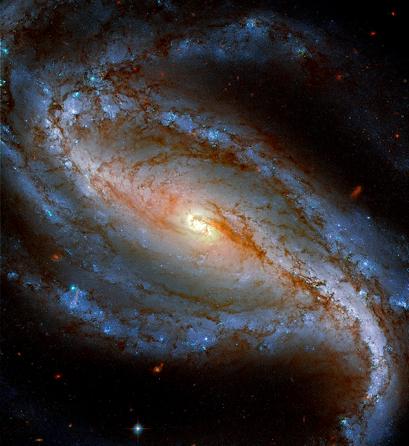

Sk y C an dy
A visit to the universe we cannot see A BAR WALKS INTO
First edition published May 2024
Atelier Books LLC
PostNet 18 P. Bag X1672
Grahamstown / Makhanda
Eastern Cape 6140
South Africa
email: atelierbooks@gmail.com https://issuu.com/douglasbullis
The right of Douglas Bullis to be identified as the author of this work has been asserted by him in accordance with the Copyright, Design, and Patent Act of 1988.
All images Copyright © 2024 by their respective creators.
This publication was produced by Douglas Bullis for free download by anyone who wishes to study the contents. It is available as a downloadable PDF from https:// issuu.com/douglasbullis/docs/ sky_candy_4_galactic_bars_72dpi_9_mb. Readers are encouraged to use a print-on-demand service to reproduce this essay for your bookshelf or classroom use.
About the weblinks in this issue
Sky Candy articles contain web links to articles and videos sourced from the astronomical literature. These web links are reproduced in CYAN on pages with a dark field. Traditional links on a white background appear in the traditional blue.
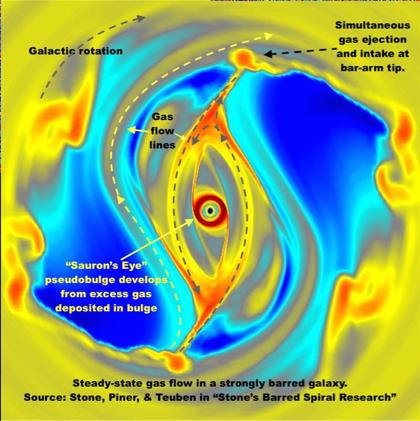
Still frame from Gas flow in Barred Galaxies, a six-second simulation of gas flow in a late-stage barred spiral galaxy by Jim Stone of Princeton University. Click on the cyan-coloured link to visit the website and watch the sim in action.
WHY SKY CANDY?
Sky Candy explores the beauty to be found in a very abstruse subject — astrophysics — but intentionally avoids losing our way amid the mathematics of that science so we can hold our focus on its beauty. We explore the visual terrain of images, maps, and graphs that until now have been known mainly to astrophysicists — well-known objects as seen via the ninety-nine percent of the electromagnetic spectrum that our eyes cannot see.
Visual astronomy is limited to a tiny portion of the electromagnetic spectrum, 380 to 700 nm. At times it is the least informative of the many spectral bands that astrophysics studies. As recently as seventy years ago we had little idea what the other ninety-nine percent actually looked like. Now astronomers can record that other ninety-nine percent and translate it into images anyone can understand.
To fully portray any given topic, we read the most important articles in the professional literature, then summarise the findings in words familiar to any astronomy enthusiast.
Art and astrophysics might seem at opposite ends of the mental spectrum. Yet they share a uniting thread: Art explores the universe within. Astrophysics explores the universe without. Together they more fully reveal our place in the universe.
The title of this series might seem to trivialise two of the most compelling interests of humankind — art and astronomy. Candy, after all, provides a fleeting enjoyment which adds little net benefit to the consumer’s well-being. Art and astronomy do just the opposite. We delight in a box full of eye candy. Why not do the same with sky candy?
What explains the extraordinary diversity of galactic bar shapes and sizes? – 2
How do stars migrate in and around their galaxies? – 4
Where do galaxies get their gas? – 8
What is a bar’s job description? – 9, 31
What turns a spiral arm into a galactic bar? – 14
What is angular momentum transfer? – 16
More energy that doesn’t shine: Magnetic fields and sound speed – 21
Case studies: NGC 1300 Eridanus, NGC 1672 Dorado, NGC 4394 Coma Berenices, NGC 3081 Hydra, NGC 1433 Horologium – 24ff
References — 36
Why do galaxies make central bars?

And once they are made, how do they affect their neighborhood?

The bar structure of M106 in Canes Venatici is readily seen as searing emission shown in the traditional blue used to signify x-ray emission. The two x-ray arms are starless gas that originated as jets of ions blown out of matter spinning at extreme velocities into the black hole core. As the jets roar outward through the ambient spiral arm, they heat up and carry away significant amounts of the gas in the galactic plane.
What explains the extraordinary diversity of galactic bar shapes and sizes?
Galaxies are so luminous in the optical bands of the spectrum it is easy to think of them as mass that shines. But what happens if we consider galaxies not as mass that shines but as energies that don’t shine: momentum, inertia, magnetism, torsion, shear, absorption—even the dark energy about which we know little beyond the fact that it certainly doesn’t shine?
From the cover page image of NGC 613, it may seem that barred galaxies are galactic astronomy’s messiest housekeepers. If we consider a galaxy only as mass that shines, the statement is true. Imagine that you have booked a holiday rental based on all those beautiful images of grand-design spirals, so tidy, pretty, and orderly. Then you arrive and you find you’re in a barred spiral. You can hear your wife’s response even now: “Just look at this place, will you! It’s a fright! We want our money back.”
A useful
analogue of
This would probably be a poor time to inform your wife that a barred spiral galaxy is astronomy’s most glorious embodiment of energy that doesn’t shine: “The chaos of a barred galaxy’s arm-bar connection is an exquisite fuel pump that keeps the galaxy from exploding in the middle while running out of gas in the outskirts”, or “All those beautiful starry dust bunnies in the far outskirts get their energy from that bulgy, squishy thing in the middle.”
Distribution, Velocity Dispersion, plus walk-on parts for [Fe/H], [Na/O], [Ti/ O], [Ba/Eu], and cosmic rays.”
You needn’t tell me your wife’s response to this: I’m married, too.
So let’s skip the casting call and introduce two unknown hopefuls to see what they can do: Negative Specific Heat and Angular Momentum Transfer.
And who are they? Heat is the energy arising from the random motion (kinetic energy or E) of the particles in a given volume. Temperature T is the amount of heat present in an object, expressed in a defined scale. In our play the scale is Kelvin, or K. Zero K is –273.15 Centigrade.
heat capacity is trying to push a balloon to the bottom of a swimming pool versus letting it rise to the top. It takes your energy input to push it down, but rises to the top by itself if you simply let go.
One must concede that this may not be the best way to endear your star gazing hobby to the person who wishes you would get to bed at a more reasonable hour on those long nights when there’s no moon.
You can always give astronomical conventions a literary spin by pointing out that barred galaxies are a Shakespearean drama with a huge cast of exotic characters, many acts, and a multitude of scene changes. In the end the protagonist commits suicide (several times), half the characters have met violent ends and the other half have lost their personalities. All this as the once brilliant stage lights dim into cimmerian night.
If you fancy the dramatic you can try, “The play is about the multi-billionyear life span of the bar in our Milky Way galaxy. It has a remarkable cast of characters: Mass-Luminosity, Tully-Fisher, Age-Metallicity, Spectral Energy
Specific heat is the heat required to raise the temperature of a given mass of a substance by a specific amount. Negative specific heat happens when gravitationally-bound systems gain kinetic energy as they lose nuclear energy. A steaming cup of coffee is an example of negative specific heat. The liquid contracts (cools) as the kinetic energy of steam (heat) is lost to the surroundings. When main-sequence stars radiate energy into space, they contract to maintain their heat balance; they retain the same average kinetic energy, but in a smaller volume. As a satellite orbiting Earth slows down from atmospheric friction it moves to a lower orbit and higher kinetic energy (velocity). As a star cluster in equilibrium with its surroundings radiates thermal energy away as light, the cluster loses heat capacity and contracts. Gravity pulls the more massive stars closer to the centre while the lightweight stars out on the edges lose energy and escape or “evaporate” into the galaxy as field stars. The more familiar term used for this is “mass segregation”.
Negative heat capacity is the amount of energy a system requires to remain in its most tightly bound state. Galaxies are the most complex example of what happens to a system with negative heat capacity. Galaxies evolve toward the most tightly-bound configuration their mass and energy permit them. Elliptical galaxies arrive at this state when the combined orbital velocities of all their stars provides enough thermal kinetic energy (heat) to balance the inward force of gravity. Spiral galaxies do it by rotating.
Spiral galaxy arms are triple-schizophrenics: their dense stars rotate in one direction; their light, loose gas clouds rotate in random directions; and their heavy dust particles blow whichever way the wind blows. None of these move in tidy perfect circles around the galactic centre. They wobble up-and-down, inand-out, fore-and aft with respect to a perfect circle. The motion of a given volume of stars, dust, and gas is more accurately characterised as a bunch of different-sized BBs rolling inside a hula hoop which wobbles irregularly up and down it loops around your wriggling waist. The combined motions of all the particles in the volume are so random (stochastic) the fastest computers we can make go down in defeat after two years of trying their best.
The lamentable fact for galaxies is that they will never achieve dynamic (thermal) equilibrium. Their stars lose energy via radiation. Their huge gas clouds collapse into myriad tiny stars. Gas and ions lose energy as they convert their motion into magnetohydrodynamic shocks. Friction robs energy from gas clouds as they brush past each other. Magnetic fields dissipate energy as they dampen out shock waves. Rotational, vibrational, and electronic transitions convert molecular energies into photons. All these increase negative heat capacity. Galaxies respond by spreading out. The name of the energy carrier that accomplishes all this is angular momentum transfer.
How cats and galaxies steal from each other’s food dishes
Stars and gas in galaxies are like two sibling cats. They cozily sleep next to each other. When they wake up they steal from each other's food dishes. They hiss. They yowl. Fur flies. Then time for a nap.
Put a little more formally, within a gravitationally bound system the total amount of momentum remains constant. It is neither created nor destroyed, but it can be transferred (i.e., from cat to cat) by specific heat (cat food). The visual evidence of heat transfer is local thermal disequilibrium (flying fur). The aural evidence is hisses and yowls, which astronomers more loftily call “star formation.” Momentum transfer explains phenomenon as diverse as:
• Why red giants expand and then contract.
• Why AGB stars turn into planetary nebula.
• Why a threesome of stars in a cluster will hurl the smallest one completely out of the cluster and then settle down as a more tightly bound pair closer to the middle of the cluster.
• Why star cluster outer halo stars evaporate into the galaxy while their centre stars crowd more tightly.
• Why massive Jupiters clear out debris discs between themselves and their parent star.
• Why galaxy bulges start out tiny and get big while the stars in the spiral arms drift higher above and below the disc plane.
• Why central bars come and go without destroying the spiral arms.
• Why dwarf galaxies are preferentially arranged in polar or equatorial planes of their host galaxies.
• Why galaxy poles preferentially align along the direction of incoming gas flow along cosmic filaments.
Momentum is the product of the mass m and velocity v of an object; it is a linear vector. Angular momentum is the circular equivalent of linear momentum. Linear momentum is the vector of your car going along a straight road. Angular momentum is the vector of your car going around a curve. On earth the relation between negative specific heat and angular momentum transfer is readily seen in satellite videos of hurricanes. As the sea adds heat to the air, the heat’s kinetic momentum has to go somewhere. Satellite videos show the outer regions of the hurricane fanning outward from the edges even as the arms are spinning inward toward the hurricane’s “eye”. (1, 2, 3.) But where — and how — does incoiling energy transfer into exterior spreading? In galaxies excess angular momentum accumulating in the core rises into the low-density inner halo above the bulge, then spreads outward across the disc into the distant spiral waves beyond the galaxy’s co-rotation circle (Fig. 10 below). While hurricane arms visibly spread away at the edges, galaxies don’t spread their momentum outward so dramatically because dark matter constrains disc spreading. Instead, the gas initiates star formation in the outer disc. That is why we find bright young star clusters quite far out into the spiral outskirts, which is a regime dominated by atomic rather than molecular hydrogen. Atomic hydrogen can’t make stars; molecular hydrogen does it easily.
How do stars migrate in and around their galaxies?
Stars and gas clouds rotate around their galaxy centres rather more erratically than our schoolbook texts told us. Galaxy discs liken somewhat to an old 33 rpm record left in the sun too long. Galaxy discs are thicker and not rigid, yet they can still warp from excessive heat. Their stars behave like tiny beads on a lumpy surface that is constantly shifting beneath them. They wobble (a) up and down vertically, (b) in and out radially toward the centre of the galaxy, and (c) fore and aft along the tangent vector of their rotation. The stars in an arbitrary volume, say a sphere 1 kpc (3260 ly) in diameter, behave more like a swarm of bees buzzing every which way inside a swarm while the swarm itself
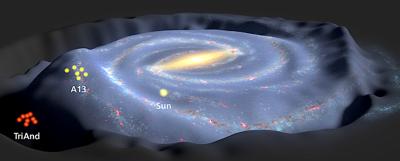
Fig. 1: A few years ago Bergemann et al 2018 studied two groups of stars in the outer Perseus Arm that seemed very far apart from each other yet exhibited nearly identical spectral signatures of element composition, age, size, and velocity. There was a high probability that the two star sets originated in the same molecular cloud collapse but were later separated across thousands of light years by a large warp in the Perseus outer arm. The warp resulted when a smaller but still quite massive galaxy punched through the outer MW disc billions of years ago. The interloper was stretched into a long stream and eventually absorbed into the Milky Way. The splash of its passage so disrupted the disc that stars born in a small region millions of years ago showed triaxial (3-D) velocity components that differed significantly from stars born more recently in the same area.
“Self-gravitating systems evolve toward the most tightly bound configuration that is reachable via the evolution processes that are available to them. They do this by spreading – the inner parts shrink while the outer parts expand – provided that some physical process efficiently transports energy or angular momentum outward. The reason is that self-gravitating systems have negative specific heats. As a result, the evolution of stars, star clusters, protostellar and protoplanetary disks, black hole accretion disks and galaxy disks are fundamentally similar. How evolution proceeds then depends on the evolution processes that are available to each kind of selfgravitating system.” (John Kormendy, Secular Evolution in Disc Galaxies, Canary Islands Winter School, 2013)
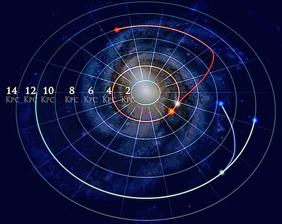
Fig. 2: A wandering star can move a long way in several billion years. Michael Hayden et al 2015 found that up to 30% of chemically mappable red giants originated in locations far from their current homes. Some of their migrations originated when massive binary stars ejected a smaller interloper (the 4 kpc ejected star above). Other stars were disrupted by massive giant molecular clouds or by passing through the Galactic disc (the 12 kpc star above). At up to 10 million M molecular clouds are the most disruptive objects in a galaxy disc.
Stellar migrations in and through a galaxy disc are complex and at times nearly inchoate. At the solar radius a star takes about 230 million years to make a circuit at a forward orbital speed of around 220 km s-1 (estimates vary). Yet at the same time our Sun’s orbit oscillates 200 pc above and below the disc every ∼64 million years. The Sun also wobbles in and out radially toward and away from the Galactic centre every ∼150 million years. Each of these motions is epicyclic. Merged into a common vector they become an eigenvector in a given sample volume filled with other stars. each of which has its own vector set. The main cause of the constant disruptions of stellar vectors around a galaxy is the scattering effect of giant molecular clouds, star cluster relaxation, and supernovae shock fronts.
The Sun circles the Galaxy in a wobbly path that continually changes in response to the large, irregular mass concentrations that pervade a galactic disc. The Sun is currently about 8.5 kpc from the Galactic centre and about 20 pc above (north) of the Galactic plane. It is moving radially inwards toward the core at 10 km s-1, tangentially forward at ~5 km s-1 faster than the average star at this radius from the Galactic centre, and about 7 km s-1 vertically from the the Galactic plane. In a side view it would look like an eccentric ellipse with a very large precession (Fig. 4 opposite).
Fig. 3: The presence of spiral arms, the Galactic bar, and the clumpy presence of giant molecular clouds significantly perturb the Sun's orbit around the Galactic disc. Predicting the location of the Sun in the disc is a vector arrow in a Poisson distribution (probability function) that is stable for only a short time.
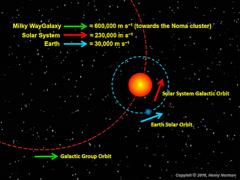
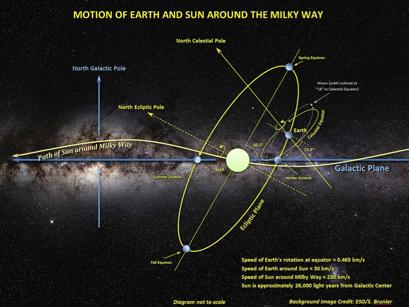
Fig. 4: A star has three ranges of motion (epicycles) as it rotates around a galaxy: up and down, side-to-side, and fore and aft along the vector of its forward path. The Sun’s main deviation from a true circle around the disc is up and down. That motion was likely imparted by the gravitational fields of massive molecular clouds which the Sun has encountered during its ±17 orbits around the Galaxy. The Solar System traces out a three-phase (triaxial) sinusoidal path in its orbit around the Galactic centre. Using Galactic North as the inertial frame of reference, the Earth and Moon rotate counterclockwise. The Earth likewise revolves counterclockwise around the Sun. The Sun and its satellites in turn revolve contrarily CLOCKWISE around the Milky Way.

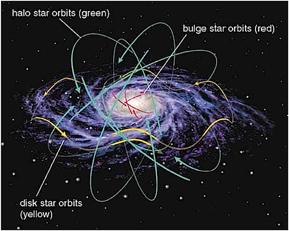
Fig. 5: Using the beeswarm analogy, a 10 pc parcel of stars centred on the Sun rotates around the galaxy in a near-circle, but the stars within each parcel have their own significant peculiar motion in relation to the others. The most significant perturbation on a parcel will be its transit through a spiral wave. Low-mass clusters are scattered during an arm crossing.
Fig. 6: Disc galaxies have three major families of stellar orbits around the centre. Bulge stars rotate in quasi-ellipses that are constantly rearranged by the stars swirling around them. Globular clusters and elliptical galaxies share this life of orbital inconstancy. Disc stars are described in more detail in the text. Halo star orbits are large, slow, and nearcircular.
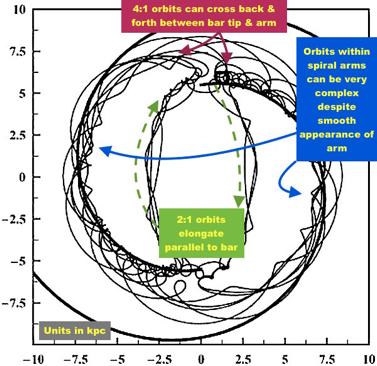
Fig. 7: Variations of peculiar orbits in a sample of six stars rotating around a barred galaxy. The lines here show star paths along their guiding centres, not the rotation of the entire ensemble around the galactic centre. This orbital plot traces a central bar extending into a spiral arm in the early stages of the bar’s evolution. Even projected on this simple 2-D surface, the paths are so disorderly as to defy description. Considerable crosstalk occurs between adjacent galactic arms and the newly developing bar at the bar ends. Dispersion initiated during molecular cloud interactions becomes inchoate from bar-arm stellar and cloud mass interactions.
Turning chaos into order
The original 1929 Hubble system provided the first ordering of galaxies that represented more than mere changes in optical appearance. In 1959 Gerárd de Vaucouleurs examined the central regions of galaxies and classified galaxies into strong bars, small or weak bars, and non-barred galaxies. He denoted non-barred spirals as SA, barred spirals as SB, and intermediate (weakly barred) galaxies as SAB. A core with an inner ring would be classified with the subset term (r), core spiral (s), and combination (rs). de Vaucouleurs estimated the Milky Way’s morphology type to be SB(rs)bc. de Vaucouleurs also noted ring-like features in some galaxies, designating those as R or (R) – the latter being a pseudo-ring formed by tightly wound spiral arms. Rings form when a resonance between the orbital speeds of stars in the disk match a global pattern which transports stars and gas radially along the bar into the centre of the galaxy. Strong rings without a bar point to the bar itself having been dispersed into the ring.


Hubble – de Vaucouleurs Galaxy Morphology Diagram
In 1961 Allan Sandage published his own revised Hubble sequence (4) as an atlas. As data accumulated for large numbers of galaxies, physical parameters for colour, HI content, concentration, and surface brightness were devised so these varied properties could be cross-correlated. Today the sequence of morphology encodes complex information about the physical pressures that underlie the properties of galaxies.
Where do galaxies get their gas?
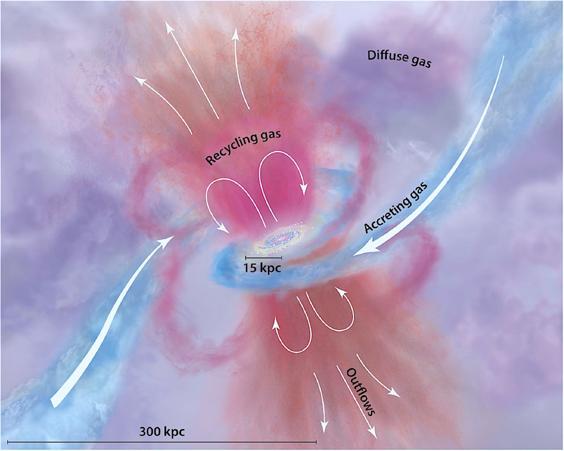
Fig. 8: A spiral galaxy's central bulge and gaseous disk are continuously replenished with primordial hydrogen pulled out of immense cosmic voids by the gravitational potential of the filamentary threads that are aptly named the Cosmic Web. The inflowing gas from the Cosmic Web (blue) accretes into the galaxy disc along flow lines that enter into the galaxy’s direction of rotation. That explains why most galactic poles align roughly perpendicular to the filaments that feed the discs. Star formation and supernovae in the disc plane eject gas at high velocity in all directions, but a galaxy’s magnetic field tends to redirect the flows into outflows perpendicular to the plane. Gas with insufficient momentum to reach the galaxy’s escape velocity eventually slows and falls back into the disc––helping enrich the disc with more and more chemical elements. Gas escaping with high enough velocity to leave the galaxy becomes part of the Intergalactic Medium, which has such a high kinetic energy load that its temperature lies in the 10 million Kelvins range. Despite that formidablesounding temperature, the number density is so low (e.g., 1 particle per cubic metre) that the gas retains its high kinetic energy simply because there is very little to bump into and slow it down. The migratory pattern of gas ejection and later return can take hundreds of millions of years. Refilling a galaxy’s gas tank is not a hasty stop at the local pump.
Source: Tomlinson, Peeples, & Werk 2018: The Circumgalactic Medium. Annual Review of Astronomy and Astrophysics 2017. AA:1{46). arXiv non-paywall here. (5)
What is a bar’s job description?
A far back as 1964 Gerárd de Vaucouleurs suggested that our Galaxy might be a barred system. Eleven years later Duus & Freeman (6) suggested that bars and inner rings are secular rearrangements of spiral arm disc matter. “Secular” means taking longer than a galaxy crossing time. At the time data was neither exact nor abundant enough to suggest that most spiral galaxies have been barred systems at least some time in their lives. The few unbarred galaxies that have never shown signs of bar activity are called bulgeless galaxies, e.g., M33, M63, and the “Fireworks Galaxy” NGC 6946. Once conditions became energetically favourable for bars to form about 7 billion years ago, so many galaxies took advantage of the opportunity that 70% of galaxies visible to us today have bars of one kind or another. About 30% of these are visible only in the infrared due to dust in galactic discs. As is often the case, impressions based on visual observations are unreliable, a phenomenon called selection bias. (7)
Barred galaxies are frequent visitors in astronomy magazines because of their visual appeal. But why do bars form and how do they evolve? For a quick primer, watch this N-body sim (8) which portrays events across 7.5 Gyr.
Barred spirals were proportionately few until the universe was about half its present age, z = 0.84. In earlier epochs disks were either too dynamically hot or too low-mass to initiate the slow, quiescent evolution of bar formation.
Bars originate in a density perturbation radiating from the centre of the galaxy which squeezes the orbits of stars at the inner Lindblad resonance from circles into shallow ellipses.
rotation they make around the galaxy at their radius. Bars become stronger and longer in time while their rotation speed slows down. Bar rotation velocities are called pattern speed to distinguish from Grand Design rotation velocity. Spirals are known to alternate between barred and unbarred states in which bars self-destruct and reform as a result of their own overacquisitiveness. The term “bar suicide” is used to describe galactic starvation, but a more apt description is “galactic crash diet”.
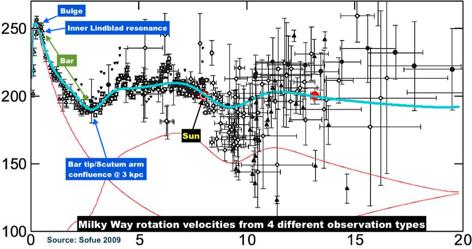
An Inner Lindblad resonance (ILR) occurs where a star's orbital speed around the galactic centre is faster than the rotational speed of the spiral arm through which it is passing. This effect builds upon itself over time, bringing stars orbiting ever further from the ILR to elongate into self-reinforcing families of ellipses (see X2 family orbits in Fig. 12). To oversimplify a complex interaction of mechanics and pathways, bar stars shuttle across the bar twice for every circular
2008. (9) The rapid drop in rotational velocity between the Inner Lindblad Resonance and 3.5 kpc bar-arm confluence suggests a maturing bar whose rotational pattern speed is not yet uniform along its length. The large error bars beyond the Sun and co-rotation torus reflect uncertainties induced by source crowding, differential extinction, and small number statistics.
Fig. 9: Rotational velocities along Milky Way disc plane as presented in SofueFig. 10: Almost nowhere in a galaxy do disc stars travel in the tidy circles of coffee-table book depictions. As stars orbit a galaxy, they are veered about by massive molecular clouds, close swing-bys past star clusters, near-misses with more massive stars or binaries. A star’s everchanging vectors move through many configurations over a single star’s circumambulation around the disc. A velocity-position measurement today will be different the next time a measurement is made. At any one instant a group of stars in close proximity to each other, e.g. a 10 pc cube, have individual vectors that collectively resemble bees swarming inside an elliptical ball. Over time individual orbits in a 10 pc cube mutually exchange energy with each other while also avoiding direct contact, rather like the N-body sims which depict them resemble gnat clouds in summer. In the bulge stars travel in ellipses around the core as shown by the black ”standard unit” in the image caption. At the Inner Lindblad Resonance (ILR), the standard unit stretches into two orbits around the disc plane. The galaxy's spiral wave rotates just once during that time, so the standard unit nutates into two lozenge shapes. Between the ILR and the co-rotation radius where the star orbits and spiral wave orbits are the same speed, the stars oscillate in and out and above and below the idealised circular path (shown at an angle here). The traces of their paths drift outward into various forms of gravity-constrained rosettes and loop-de-loops. At co-rotation the various triaxial eccentricities in a star's orbit gives it a path that constrains within 3-D ellipses that advance forward slightly with each time unit (the bee-swarms described above). Beyond the outer Lindblad Resonance (OLR) the stars orbit in leisurely ellipses that appear to travel in the opposite direction to the spiral wave. (They are not actually traveling backwards in the galaxy, only with respect to the spiral wave because the wave’s clockwise rotation speed is faster than the clockwise speed of the stars.) Stars’ peculiar motions are more radically perturbed as they enter into and depart from a spiral density wave. Source: Kormendy 2013. For more details about Bertil Lindblad see 10, 11, 12., 13.
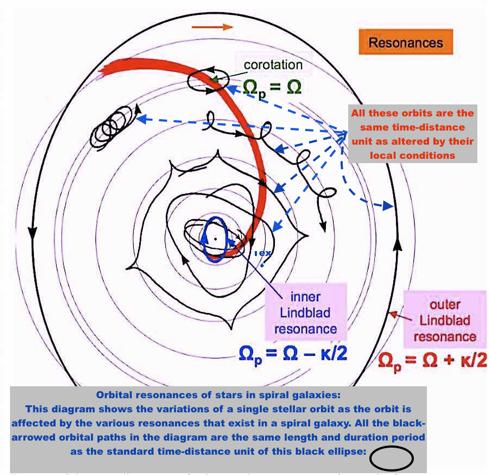
In the regions dominated by the Outer Lindblad Resonance, as spiral waves pass through the stars the stars are torqued inward toward the centre of the galaxy by the aggregate gravitational pull of the arm around them. OLRs typically have enhanced neutral hydrogen compared with ionised Hα ratios, a signature of quiescent gas.
If ILRs tend to move stars outward in the disc and OLRs tend to move them inward, where do they balance each other?
The name for this is the Corotation Resonance. The CR is that slender hulahoop rotating around a galaxy which was invoked earlier. In the CR stars and the spiral wave advance forward at close to the same speed (e.g., ±254 km sec-1). In principle CRs are one of the few quiet neighbourhoods in a galaxy. The strongest disruptors are relatively lazy giant molecular clouds (GMCs) and star clusters ejecting gas. Supernova shock front disrupt abstemiously because they pass through so quickly. The CR regime is rippling ponds compared with the boiling-pot high-velocity turbulence bubbles from multiple starburst regions that dominate galactic life between the the galaxy’s bulge and the CR corotation resonance.
Although GMCs in the CR rotate around the centre at roughly the same speed as the arm and the stars, they also have their own peculiar velocities. GMCs are migratory — like the 800-lb gorilla they move where they want and sit where they want. The highest velocity component in most GMCs is their z or vertical infall component. Many of them arrive from the galaxy’s halo and even from outside the galaxy itself (See 14, 15, 16, 17). GMCs can easily strip star clusters of their stars — and just as easily make new star clusters to replace them. One of the main functions of bars is balancing the angular momentum generated by different parts of the galaxy — especially the tumultuous region between the bulge and the CR — in a process called virialisation. Bars swerve gas from circling the galaxy to moving along the bar — an almost 90° swerve that requires an enormous amount of torque energy. Most of the gas overshoots and settles in to x1 orbits that shuttle back and forth from arm to arm across the bar. Whenever there is relatively rapid gas accumulation there is usually rapid star formation and subsequent gas ejection.
This 3-D video slice-through (18) explains it better than words. Bars play a major role in driving the evolution of disk galaxies and in shaping their present properties. They eject excess matter (mainly molecular hydrogen) from the
Inner Lindblad Resonance of the bar into the spheroid of the ancient core and halo. It then flows outward toward the edges of the galaxy’s disc. The outer arms in a spiral galaxy are mainly atomic hydrogen, which does not fuel star formation. Yet quite a bit of star formation does occur out there —witness the Double Cluster and all those beautiful star-forming nebulae in the Perseus Arm. Those clusters are young molecular cloud progeny. Where does their gas come from? Recall from the hurricane analogy on p.4 that kinetic energy (heat) flows inward along the spiral waves. In galaxies the heat (gas atoms in motion) gives carbon-based dust grains enough energy to catalyse a two hydrogen atoms -to- molecular hydrogen by the reaction (2H1➞H2+e–). Molecular hydrogen is the basic fuel for star formation. Hence galaxies form more stars inside the corotation radius than in the outskirts.

Fig. 11: Bars redirect large amounts of gas into the bulge to fuel star formation. Over time, more gas is delivered to the bulge than it consumes. Angular momentum transfer shifts some of the excess gas above the disc plane, where it then flows outward like a slow, even wind. Note that this drawing is not to scale. Moreover, angular momentum transfer does not equate directly to gas particle transport. Angular momentum is a force carrier that may or may not have particles embedded within it.
Bars are a complex gas machine that links a conveyor belt to the furnace. Bars originate as a perturbation in a young galaxy's core, which reshapes the chaotic orbits of spiral-arm gas and stars into slightly elongated structures which evolve their own set of processes and contents. There are differences between the effect a bar has on a spiral arm’s dust and a spiral arm’s gas. Gas and dust move coherently until an outside force causes the gas to speed up, at which point the two part company (decouple). This is why the leading edge of many bars show long dark linear streaks of dust.
Even though a spiral arm’s gas forms only about 10% of its mass, its behaviour in large concentrations wreaks enormous effects in a galaxy. Interstellar gas is shifted from a galaxy's spiral arms toward the core by the bar's gravitational churn. Violent bursts of star formation follow, with subsequent supernovae. Supernovae expel large quantities of gas into the galaxy’s halo, where some of it falls back onto the disc and some is hurled into the galaxy’s halo far out in its outskirts (Fig. 8 above).
Bar perturbation originates in a rotational instability in the Inner Lindblad Resonance (Fig. 9 above). ILRs destabilise the infall of gas along the spiral arms into the core. At first the bars are short, broad-shouldered, and vertically thin. Bars in galaxies with larger central mass concentrations are shorter, but broader and thicker.
Over spans measured in hundreds of millions of years bars progressively lengthen and become slimmer along their lengths, but also thicken vertically. Over time bars feed enormous quantities of gas from the spiral arms into the galaxy's bulge. Only a certain portion of it is actually retained and processed by the bulge. The inflowing gas is processed in three ways:
1. Massive gas inflow into the bulge initiates a long-lasting round of star formation. The Milky Way’s most massive star clusters—Arches, Quintuplet, Central—are very young, massive, and hot in a part of a spiral galaxy that gave birth to and still hosts the oldest stars in its history. Bar inflow also feeds supermassive black holes — the Milky Way’s BH is 4.5 million M .
2. The galaxy’s core can consume only so much inflowing gas by making stars. Part of the excess goes into fuelling a new central structure: a pseudobulge. (NGC 1365 Fornax has a prominent pseudobulge.) Gas flowing inward along bars produces dense, thick inner bars, and eventually mini-spirals within the bulge, hence its
new name: pseudobulge. The pseudobulge thickens axially (vertically) until the inner bar buckles upward from instabilities induced by stars “scattering” away from the bars. Scattering is a heating process. It injects the additional kinetic energy of random motion into the system. The system responds by moving the energetic particles further apart in a process called adiabatic equilibration. Rotation turns a local wave shape into the vertical buckle of a pseudobulge. (See 19, 20, 21) and this convenient overview compilation, 22)
3. Bars transfer angular momentum from the core to the galaxy’s outskirts. Angular momentum in this context is not composed of moving particles, but rather the potential energy of myriads of particles whose momentum has been stored up in the galaxy in the form of rotational velocity. The angular momentum imparted at the Inner Lindblad Resonance of the bulge is partly absorbed by star and gas mass in the spheroid (the ancient core and halo). The rest of the angular momentum transfers to the outer disk, where it fuels star formation.
Bars eventually degrade themselves by their very efficiency — an event called “bar suicide”. Over-accumulation of mass in the galaxy's centre eventually disrupts the orbits of the bar’s stars, which in turn dissipates the bar until it no longer has the potential energy to attract fresh gas. The dissolving bar is replaced by a newly emerging pair of spiral arms propagating outward from the bulge (see Fig. 29 of NGC 1672 Doradus below). Hence bars are transient phenomena in the lives of spiral galaxies. They decay over time, transforming galaxies from barred spirals back into more traditional spiral patterns. This begins the cycle anew — a strong bar weakens into a new spiral, which in time grows massive enough to feed a new bar.
What happens to stars in those bars?
Galactic bars looks featureless and serene in optical pictures but their languid appearance is an illusion. Stars in spiral arms are torqued sharply into taffylike streams in the bars which distend into rotational families that look rather like a race-car driver’s view of the Indianapolis 500 Speedway. The stars are completely decoupled from the gas, but the light emitted by the gas is so much more abundant than the stars’ light that most images only show the gas. Many stars overshoot the bar tips and end up in arms on the other side.

Fig. 12: The torque and shear forces that disrupt the spiral arm’s gas clouds are so strong that they decouple gas from its clouds and stream the gas into a featureless surface. Two orbital families result: those which shuttle back and forth from spiral arm to spiral arm, named x1, and the initial-stage perpendicular family, x2, that will eventually evolve into a pseudobulge. Source: Bournaud & Combes 2002 (23).
Fig. 13: When galaxy bulges accumulate bulge-to-bar mass ratios of ~62%, shear forces induced by the bar’s orbiting families induce the formation of a secondary bar inside the ILR of the bulge. The new inner bar has the same features as a spiral arm bar, e.g., a surface brightness profile that rises dramatically to a peak in the centre. The formation of a nuclear bar is strong evidence that a galactic centre is dominated by a pseudobulge. Pseudobulges become unstable at high densities. They feed the galaxy’s central black hole so violently that the result is an Active Galactic Nucleus or AGN. The AGN galaxy M77 (NGC 1068) in Cetus is a frequent stop on the amateur community’s observing list. Source: Kormendy 2004, Fig 14 (24).

What turns a spiral arm into a galactic bar?
The only thing than can make a river turn a corner is a riverbed. But there is no riverbed in a spiral galaxy. What kind of force is so powerful that it can swerve the immense mass of a rotating spiral arm abruptly into a 90° corner and move that mass along a horizontal bar that ends up disrupting the entire middle part of the galaxy? How can a gassy, starry galaxy make the astrophysical equivalent of a riverbed?
Inside a spiral, the surrounding medium behaves like a gas mixed with many solid particles, i.e., a fluid. Seen on a larger scale from the outside, galaxies look like a viscous fluid being churned by an invisible paddle. Let us isolate the middle section of this paddle and call it “Inner Lindblad Resonance”. The ILR paddle originates because the velocity of a galaxy’s rotating fluid is higher than the Reyleigh discriminant (25). Even a tiny disturbance can cause an eddy in the rotating flow. Galaxies are constantly perturbed from outside by the tidal stresses of nearby galaxies. Once an eddy forms it strengthens into a pimple-like bump. In galaxies a counterpimple forms on the opposite side of the eddy because of the natural epicyclic oscillations of waves in fluids. (This doesn’t happen with earthly rivers.) When the pimple extends far enough into the viscosity that tiny eddies form behind it, we have a paddle, or rather, a bar. If the bar’s rotational (orbital) speed around the centre is faster than fluid’s natural oscillation frequency, a self-reinforcing resonance is set up — the Inner Lindblad Resonance. Inside the circle the fluid wants to rotate around the centre; outside the ILR the fluid wants to flow along the paddle. A short paddle (newly developing bar) creates tiny eddies along its lee side. Those eddies propagate all along the length of the bar until in time they reach the opposite end. There the eddies mix with the freshly arriving fluid on the front side of the bar as the bar churns around and around. The result is chaotic turbulence. The region this turbulence occupies is called a Lagrange point.


Rotational vectors flow around a central force unless disturbed by an outside force. Large perturbations respond to a one-time disruption, then carry on in their new configuration until disturbed again.
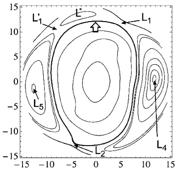
Source: Athanassoula 2012 (26).

Shear tensors are a common flow of many individual perturbation vectors responding to multiple external forces.
Fig. 15: Two main types of large-scale perturbation can result from a tiny ILR elongation: one-time disruptions, and multiple self-propagating disruptions.

Fig. 16: On the scale of a galaxy, arms and bars behave like a fluid, not a gas. The myriad particles of stars and gas clouds each has its vector within the galaxy’s gravitational well. The combined flow of these countless individual vectors is described by a branch of mathematics called tensors. As the above diagram shows, they can be bogglingly complex. For our needs here, the shear stress tensor of a bararm interaction is a river made of many droplet vectors united into a shear stress tensor riverbed.

Fig 17: A shear tensor is a way of calculating the actual direction of multiple interacting vectors. Calculating the cumulative effect of trillions of particles moving in spacetime requires enormous computing power.
Fig. 14: Lagrange points L1 and L2 in NGC 1300 are like eddies of a paddle that stirs its rotation.The bar-arm confluence which so beguiles our splendid Milky Way arching overhead is a walk-on part in an allegory as complex as a literary epic. For a visual simulation, see here.
The word shear has played a seeming bit part in this astral drama. Yet it is in fact a main player — not merely in our modest local drama of the Milky Way bar but in the physics of the universe itself as it shifts its energies about. We need to look at the word shear not as local event but as universal necessity.
Shear is a verb: “break off or cause to break off, owing to a structural strain”. That suggests an event that’s already concluded. To give the term scientific utility, we need to rephrase it as an ongoing event: “an evolving strain produced by pressure in the structure of a substance when multiple layers are shifted or torqued in relation to each other”. The reason we define it this way is so we can assign a numerical value to it: shear stress. Finally, we need to turn that value into a mathematical function we can apply uniformly to any appropriate situation. In astrophysics it is called a shear stress tensor (27, 28, 29).
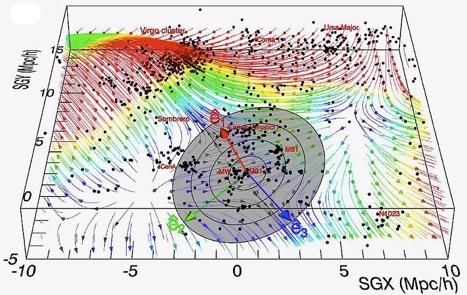
Fluid dynamical processes are the driving force behind most fundamental processes in the universe, i.e. spiral density waves in galaxies triggering bursts of star formation in the spiral arms as stars pass through it; solar and stellar flares; stellar evolution; instabilities in stars giving rise to stellar pulsation; accretion processes in binary systems; relativistic jets ejected by black holes in the heart of galaxies; and many others.
Fig. 18: The bar-arm confluence spanning the sky from Aquila to Norma is a modest example of universal physical processes that give shape to the entire Cosmic Web. In this image by Daniel Pomarède, the Local Group, M81 Group, Centaurus Cluster, and Sculptor Group are all infalling along a shear stress tensor ê3 connecting the Virgo Supercluster with the Perseus-Pisces Supercluster (located off the bottom of the diagram at about the five o’clock position). As nearby galaxies converge toward their individual common centres (e.g., the Local Group), they are simultaneously being pulled toward the Virgo Supercluster. Each galaxy has its own vector; each galaxy group has its own combined vector field; and the combined vector fields of all of them together are shaped by the Virgo Supercluster shear stress tensor. A tensor can be thought of as a supra-vector field made of many other vector fields. Tensor fields are difficult mathematically, but visually they are rather simple — to say nothing of beautiful. The profound role stress tensors play in the cosmology of the universe has become apparent only in the past few years. Image source: Libeskind 2015 (30).
What does angular momentum transfer do to
a galaxy?

Fig. 19: Still frame from six-second 1.3 MB movie simulation of gas flow in a latestage barred spiral galaxy by Princeton’s Jim Stone. Titled Gas flow in Barred Galaxies (view & download the sim here (31), the sim portrays gas behaviour only; no stars are involved. The sim reproduces the more obvious features found in real galaxy bars — recirculating gas flow within the bar, gas recycling into spiral arms at the corotation resonance, how gas flows into incoming shock waves from the opposite dust lane and then back out to collide with incoming spiral arm flow. The sim vividly portrays how gas expulsion from bar tips into spiral arms sets the stage for massive star formation at the confluence of spiral arms and galactic bars — exactly what we would see in Aquila and Norma if we could see through the intervening dust.
How to simplify something terribly complex
Galactic evolution is caused by the heating effect of random motions. “Heat” means the aggregate velocity of the system’s myriad particles. “Hot” means a lot of motion in a given volume. If the centre of the volume gets hotter than the periphery, the rising particle velocities (heat) attempts to get back into balance by flowing toward the less hot regions. When those regions receive the heat, they expand and therefore cool. The overall effect is to cause the system to spread out. Systems that behave this way are dominated by velocity dispersion. Dispersion is the change in random motion as one traverses from one side to the other. A dispersion curve looks like a bell-shaped curve, with the highest velocities at the very top of the curve and the outskirts near zero.
The specific heat of a self-gravitating system is negative, which is to say that excess heat makes it expand outwards in order to come back into balance with its surroundings.
Why is this so? Consider an equilibrium system of N particles of mass m, radius r and three-dimensional velocity dispersion v.
The virial theorem tells us that 2KE + PE = 0, where KE means kinetic energy and PE is potential energy. The number 2 is in this picture because it takes as much energy to bring a system back to equilibrium as it did to make a mess of it in the first place. Put another way, it takes as much energy to lift a book from the floor to a table as it does to return the book to the floor. We don’t notice the latter energy because gravity is doing the work for us.
• So, KE = Nmv2/2 and the potential energy is PE = G(Nm)2/r.
• The total energy E ≡ KE + PE = KE. The negative minus sign tells us that it is a bound system (positive kinetic energy makes a system fly apart).
• The temperature of the system is measured by v2, that is, mv2/2 = 3kT/2.
• Hence the specific heat C ≡ dE/dT ∝ d( Nmv2/2)/d(v2) is also negative. G is the gravitational constant and k is Boltzmann’s constant. These are properties of a system that is supported by the dynamic heat produced by its continuously interacting particles. The rate at which the system evolves depends on how efficient is its heat-transport mechanism.
=Adapted from Kormendy 2013 (32).
Where
does angular momentum transfer begin?
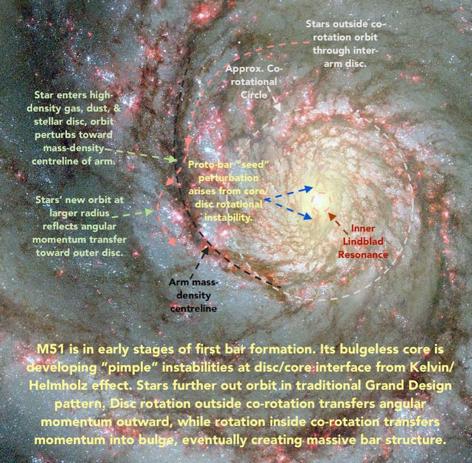
Certainty is a fleeting joy in astronomy. Numerical values are only as reliable as the measurements underlying them. Galaxies are notoriously prone to misleading evidence. Differential extinction is a bugbear to optical-band astronomy. Magnetohydrodynamic quenching (33) of turbulence is subject to local density fluctuations. Small number statistics and selection bias negatively impact the input reliability of Nbody and constrained realisation simulations. An example of how a new and more carefully constrained observation set can upset established apple carts is Reid et al., 2009 (34), who used VLBI measurements of masers in 18 high-mass starforming regions to refine the model of our own Milky Way home galaxy. Their findings were:
(1) Star-forming regions are orbiting the Galaxy about 15 km/s 1 slower than expected for circular orbits.
(2) The rotation curve was thought to be nearly flat with increasing Galactocentric radius, but this value was superseded four years later by Sofue 2009 (Fig. 9 above).
(3) The angular velocity of the Sun (30.3 km s 1 kpc) is significantly larger than the IAU value of 25.9 km s 1 kpc.
(4) Galactic centre–Sun distance R0 = 8.4 ± 0.6 kpc.
(5) Circular rotation velocity of the Sun around the galaxy is V0 = 254 ± 16 km s 1. (The old value was 220 km s 1.)
(6) The angular velocity of the Sun V0/R0 = 30.3 ± 0.9 km s 1 kpc 1 .
(7) The Galactic bar rotates as a solid body with a pattern speed of 220 km s 1 . This is 31 km s 1 slower than the spiral arms that the bar
Fig. 20: Inside a galaxy’s co-rotation radius, a star passes through the arm, the gravitational potential of the spiral wave veers the star outward from its circular path. When the star eventually advances through and out the front side of the arm, its orbit returns to circular, but is further out from the centre. This initiates the galaxy arm spreading analogous to hurricanes cited on p.4 of this work. ILRs develop near the outer edge of the bulge where it joins the arms or a bar.
What does angular momentum transfer accomplish?

Fig. 21: NGC 3596, NGC 5921, and NGC 5701 show us three stages in barred galaxy evolution.
The angular momentum (energy from rotation) of a galaxy’s stars, gas, and dust originates in the rotating frame of its spiral arms. The path traced by each star or gas cloud’s momentum is influenced by the gravitation of the entire galaxy. In normal spiral arms stars and gas follow a roughly circular track rotating around the galaxy centre. If galaxies had no gas and the stars were all identical, the stars would rotate around in nice, tidy circles.
But galaxies DO have gas. Though gas makes up only about 10% of our Milky Way’s disc mass, it is clumped together in giant clouds which exercise an outsize influence on the rotation paths of nearby stars and star clusters. Without bars, the spiral arms would slowly feed into the bulge, eventually depleting the galaxy arm gas.
The length and strength of a bar is influenced by the amount of angular momentum the halo can absorb, the length of the bar’s radial extent, and the velocity anisotropy (shear forces) of its components. There is a strong correlation between bar strength and the amount of angular momentum it injects into the halo. Part of the angular momentum is absorbed by the halo, especially near the disc plane. Halo rotation correlates with the bar strength, but is very modest indeed: the halo’s circumference just above the thick disc advances only 5° – 30° over a period of 10 Gyr due to angular momentum transfer from the core.
All the rest of the angular momentum ends up in the outer disc, where it feeds future star formation. Bars are like a heartbeat pumping fresh blood throughout the system to keep it healthy. These three galaxies reveal the different stages of the overall process.
Image source: Gavazzi et al 2015 (39).
What has angular momentum transfer done to the Milky Way?
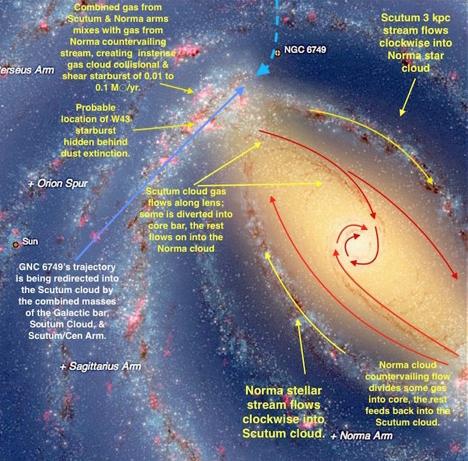
Fig. 22: The beclotted character of stellar and gas populations in spiral arms changes dramatically when they enter the chaotic bararm confluence at the outer tip of the bar. Star formation there is intense — e.g., the W43 cloud complex in Aquila. In many galaxies the spiral arm stars are de-orbited into lens-like star steams like the 3 kpc stream that flows from Scutum to Norma on the forward side of the bulge and in the opposite direction on the rear side of the bulge. The spiral arm gas that survives churning, torque shears, and magnetic fields in the confluence is revectored into long elliptical orbits along the main bar. The gas velocities are so high and pressure gradients so low that gas cannot clump into dense clouds the way it does in discs. Most of the gas that falls into the bar eventually becomes stars in the chaotic bar tips. The most interesting fate is what happens to the dust filaments in spiral arms. Dust that forms in galaxy arms comprises about 0.1% by particle count of a given volume of gas. The gasdust mix rotates in roughly circular manifolds around the galaxy core. The term “manifold” means a self-coherent tube-like feature that encircles the galaxy rather like a hula-hoop made out of spaghetti. In this analogy, the tomato sauce is the galaxy’s gas and the stars are the bits of mushroom. Manifolds do not have solid walls; matter can enter and leave them, but tends to stay inside because of internal gravitational and magnetic fields. Manifolds were originally artificial constructs devised to make Nbody sims behave like real galaxies. In 1992 Lea Athanassoula (41) pointed out that the dust filaments visible on the inner sides of spiral arms were once dispersed but now stream together as its gas cloud deforms into comet-shaped clumps upon entering a spiral arm. Being dense but of tiny mass, the dust overshoots the bar. It is slowed just enough to be gravitationally streamlined along the front side of the bar. Measurements of the gas velocities on both sides of the bar filaments revealed that large velocity gradients existed in dust filaments after they crossed galaxy bars. Annotation by the author for the publication The Winds of Change are Blowing Over Aquila, Sky Candy Special Report #5.
DIY galaxy sims
There is a formidable array of cosmology and galaxy-scale sims produced by the likes of iLLustris, CLUES, Magneticum, Bolshoi, Eagle, ICRAR, SILCC, SPHINX, and a host of other institutions and individual astronomy professors. Sims represent the universe in 4-D, whereas observational astronomy produces mainly 2D snapshots while numerical astronomy produces 3-D graphical renderings that are hard to visualise in real-time terms. The sophistication of sims and visualisations demonstrate how various phenomenon in the universe actually behave as we observe them. Sims have moved out of the mainframe world and onto your desktop. Any computer-literate amateur with a reasonable knowledge of coding and a basic grasp of astronomical physics can make their own simulations for selfstudy or to show friends. There are numerous pre-made algorithms and source code libraries which can be downloaded to a home computer. A good place to start is the BeltOfOrion.de website, which is devoted to home-brew enthusiasts who want to make their own. The Belt Of Orion Galaxy Rotation workshop provides plenty of inspiration to keep us playing in the starry sandpile for years to come. Here are four examples:





From basic websites like this you can advance to the Astrophysical Source Code Library produced by ASCL.net. A YouTube search using phrases identifying specific phenomenon, e.g. star cluster or galaxy formation sims, will bring up many others. And if you’re keen to know how they did this in the Bad Old Days (1960s), take a deep breath and start here.
Fig. 23: In a classical spiral the disc consists of gas and young stars while the bulge is made of the galaxy’s oldest stars. The core of M94 does not have an old red component left over from the galaxy’s original formation but rather a bright intense star-forming Grand Design spiral in miniature. The unusually bright outer disc shimmering with young massive stars suggests that considerable molecular hydrogen fuel was transferred there from the highly active core region during previous bar formation-dissolution episodes.
Combined stars, nebulae, & H2. Orbits predicted by density-wave theory. Orbits predicted by Lindblad rotation. Rotation producing winding problem.More energy that doesn’t shine: Magnetic Fields and Sound Speed
The years 1949 and 1950 were a great era for galaxy astronomers. Polarised starlight was discovered in 1949. Over the years several hypothesis about the origins of polarisation were devised. One was that dust grains were aligned along the spiral arms in the thin disc of the Galactic plane. That same year, Enrico Fermi theorised that these newly discovered magnetic fields were the origin of cosmic rays. One year later, Galactic radio emission first observed by Karl Jansky in 1931 was attributed by Grote Reber to the spiralling gyration of cosmic rays (mainly electrons) around magnetic field lines, aka synchrotron radiation. Across the next two decades radio observations of polarised Galactic emission and Faraday rotation (circular polarisation) confirmed that magnetic fields were significant contributors to gas transport within galaxy discs, and more importantly, above/below the discs as well.
Disc-gas churn in a galaxy has many causes—supersonic shocks, subsonic turbulence, gravitational accretion, gas hurled out of star clusters, the shear from different spiral arm velocities—but it tends to stay within the spiral arms. Magnetic fields in galaxy discs tend to be strongest in between the arms, where it is not related to the intensity of star formation. It thus must originate in free electrons moving at such high velocities they are unlikely to bond to much more massive hydrogen ions (protons).
Magnetic fields far above the galactic disc are a very different matter. They were first observed in two forms: linear streams that seemed to leave the galaxy altogether (Fig. 24) and bubble-like structures that behave like similar high-velocity superbubbles in the Sun (Fig. 25). The gas transport effect of both these types were shown in Fig. 8 above. A certain portion of gas ejected from galaxy discs lies in a velocity bin between these two; this is the gas shown is Fig. 11 that ends up in a galaxy’s outskirts to feed star cluster formation out there. Its mass tends to be greatest in barred galaxies with highpotential bar-arm confluences. The Milky Way has two such energetic overdensities visible optically as the Scutum and Norma star clouds.
So much ejected gas is lost to space that our Milky Way would run out of gas in another 2.6 billion years. However, that loss rate has somehow been replenished at least twice since the Milky Way formed its bar roughly 8 billion years ago. Where, then, is the petrol pump that fills our gas tank? We have already seen the answer in Fig. 18: from the filamentary structure that joins the
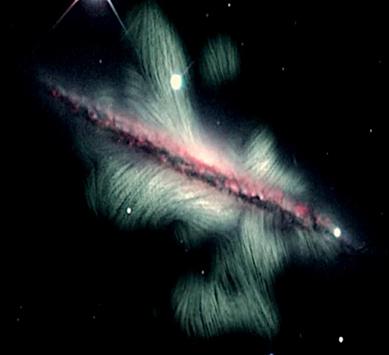
Fig. 24: NGC 4217 is an edge-on spiral galaxy approx. 18 Mpc (60 million light-years) and is a possible companion galaxy to Messier 106 in Canes Venatici. In a 2021 study by Wibking & Krumholz (42) the structure of magnetic fields and gas in simulated Milky Way galaxies occurs in the disk as wind-blown superbubbles erupting from many dozens of SN explosions and stellar winds across time spans of 100 Myr. The magnetic field orientations of the halo gas loss is synchrotron-loss dominated and occurs via an advective wind with a velocity similar to or slightly greater than the galaxy’s escape velocity. Advection is the transfer of heat or matter by the flow of a fluid.
Perseus-Pisces galactic supercluster with the Virgo supercluster, with the Milky Way’s Local Group somewhere hear the middle. The Centaurus A galaxy cluster lies to one side of us and the M81 and Canes Venatici clusters on the other side.
Back to our local problem with angular momentum transport from the Galactic bulge and bar-arm densities (see the NGC 1300 case study below), the likeliest source of mid-velocity gas that ends up with such beauties as the Double Cluster and other Perseus Arm beauties are the superbubbles shown in a recent study led by Yelena Stein at the University of Lyons in France (Fig. 25). This study was limited to superbubbles within the Galactic Corotation Radius so is a bit incomplete. Even so, it takes only a little imagination (but huge swods of computer time) to visualise where the gas comes from that makes the Perseus Arm such a pretty thing to explore. (To put the corotation radius in context, our Sun lies very close to its rotational centreline at CR=1.06.)
Fig. 24 shows the large-scale magnetic field flow patterns. The galaxy is seen edge-on in a visible-light image from the Sloan Digital Sky Survey and Kitt Peak National Observatory, and the magnetic field lines in green are revealed by the Karl G. Jansky Very Large Array (VLA) radio telescope in New Mexico. The magnetic field lines extend as much as 22,500 light-years beyond the galaxy's disk. Magnetic fields play an important role in many processes, such as star formation, within galaxies. However, it is not fully understood why such huge magnetic fields are generated and maintained mostly in barred spiral galaxies. A leading explanation, called the dynamo theory, suggests that magnetic fields are generated by the motion of plasma within the galaxy's bararm confluences. The magnetic field orientations of the polarized emission regions within the mid-plane are oriented plane-parallel but become vertical in the halo of the galaxy.
The Fig. 25 Y. Stein paper indicates how much gas finds its way out of the disc plane via supernovae-generated superbubbles that hurl gas shells >1000 pc (3260 ly) above/below the Galactic disc. Some escapes the shells’ magnetic fields and joins the angular momentum transport out to the galaxy disc, but cannot escape the galaxy altogether. The most significant contributor to gas/ field decoupling is supersonic shock turbulence from supernovae and superheated gas expelled by giant O stars in newly-formed massive clusters. The hole in the Rosette Nebula is a low-pressure example of gas clearance we can see visually. High-velocity expulsion is seen mainly in UV and X-ray images so we don’t see it.
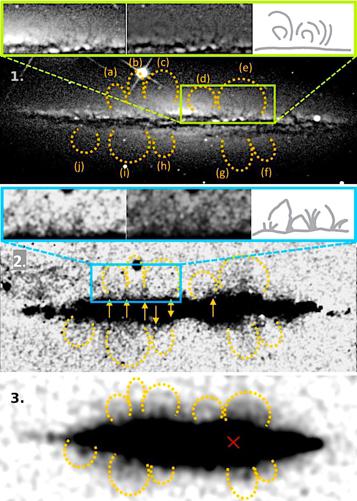
Fig 25: Stein et al 2020 (43), Transport processes and the X-shaped magnetic field of NGC 4217: off-center superbubble structure. The structures in NGC 4217 are distributed over the entire galaxy and have diameters of several kpc; they may follow the spiral structure. Dust filaments in the optical B-band image appear to follow the loops and shells of hot gas. The Hα emission is either extended smoothly within some of the structures (e, g, and i) or the two locations of the individual loop structures, where they are connected to the disk (a, b, c, d, h). The superbubble structure (e) is prominent in all investigated emissions. The yellow arrows show the dominant direction of gas expulsion. These bubbles show notable similarities to solar prominence bubbles both visually and in patterns of gas flow.
Case study: NGC 1300 Eridanus

Fig. 26: NGC 1300 Eridanus is at a more advanced stage of bar development than the Milky Way’s bar in its present stage. The colour scale of the image has been inverted to highlight the filamentary character of dust streams in the bar compared with the diffuse gas in bluish tones. Note how the dust filaments shift from the inner side of the spiral arms near the bar to the outside of the bar on the far side of the bar axis. This indicates that NGC 1300’s co-rotation circle lies inside the spiral arm where the bar and arm join (i.e., the bar tip). About 60% of NGC 1300’s mass lies inside the co-rotation circle. Each of NGC 1300's bar-arm confluences has baryon masses great enough that their gravitational potential rivals that of the bulge. Three huge mass centres occupying the length of the galaxy bar sets up competitive gravitational wells that disturb the orbits of individual stars in the arms. The strikingly quiet voids between the arms and the bar suggests that the normally circular orbits of stars in a spiral galaxy’s arms have been deformed into non-circular shapes.
NGC 1300 decoded
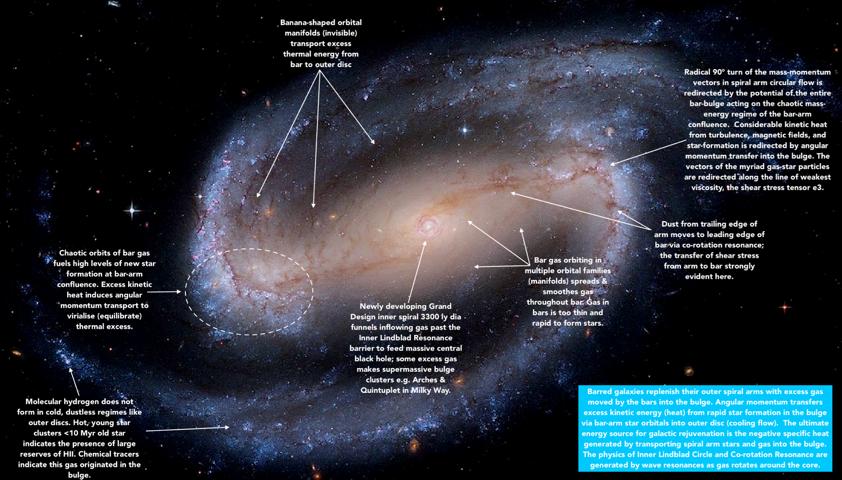
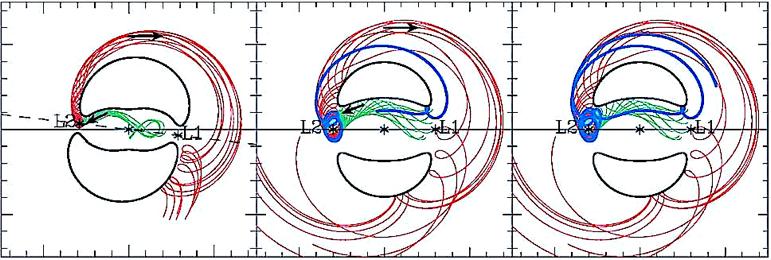
Fig. 28: Most accounts of galactic bars lavish attention on the bars. They are indeed beautiful, complex, and intricate, in the rather stiffly formal way that Bolshoi ballets were precisely structured. However, glance away from the pretty pas de deux in centre stage and take in the large view of the intricate fluttery footwork by the corps de ballet on the sides and rear stage. Imagine those toes as stars. NGC 1300’s long, graceful spirals look like they are curling inward to an inevitable fate of merger with the star factory of the bulge. Alas, not so, and for two quite different reasons. First, those arms are composed of gas as well as stars — the gas is about 10% of the arms’ total mass. The gas (curlicue blue lines above) tends to be gravitationally bound to its nearby surroundings and is swept along the arms toward the bar-arm confluence. Second, the stars are point masses that have to contend with three high-mass gravity wells: the bulge (the ✽ in the middle above) and the L1 and L2 Lagrangian points centred on the left and right bar-arm confluences. To stars at different locations in the arms and interarms, each of the three wells competes for the stars’ orbital attention. As the stars move around the disc (CCW in this case) their relation to the three gravitational wells constantly changes. Stars near the L1 or L2 Lagrange points (red lines) eventually adopt kidney-bean or banana shaped orbits so long as they remain inside the heavy blue regions above. If they wander outside the blue “bananas”, angular momentum transfer outward from the core alters their orbits such that they they end up spreading OUTWARD. Recall the spiral arms of terrestrial hurricanes spreading outward from the storm. In a 2012 paper, Manifold-driven spirals in N-body barred galaxy simulations, Lea Athanassoula summarised, “The radial extent of the arms increases with time, thus bringing about a considerable increase of the disc size, by as much as 50 per cent in about 1 Gyr.”
Source: Athanassoula 2005 (44). Image from Athanassoula 2012 (26).
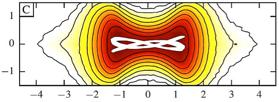
Fig. 29: Banana-shaped stellar orbitals are not related to the x1 family orbitals shown above that traverse a galactic bar. Instead, they move rather aimlessly in the interarm region until either captured at one of the Lagrangian points, or escape into the outer disc as part of the galaxy’s angular momentum transfer from the bulge to the Outer Lindblad Resonance. This drawing does not depict orbital paths, but rather the energy isopleths that collectively regulate bar shape and strength. Source: Portail et al 2015 (45).

Fig. 30: X-ray and near infrared images of NGC 1672 reveal this core orbital-support pattern of a pseudobulge.
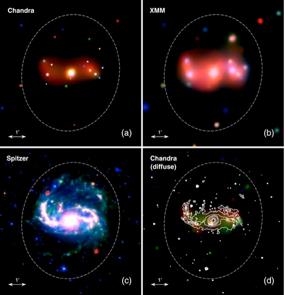

Fig. 31: As a prototype of a barred spiral galaxy, NGC 1672 in Doradus differs from normal barred galaxies in that it has two sets of spiral arms with a truncated bar joining the inner spiral to the outer disc. NGC 1672 evidences intense star formation in both the inner core bar and in the four outer spiral arms that feed gas into the inner two-arm spiral. Two of the outer arms appear to fed gas directly into the inner bulge-bar, while the larger two arms feed a more traditional bar-arm confluence near the co-rotation circle. NGC 1672 is classified as a Seyfert active galactic nuclei powered by accretion via bars feeding supermassive black holes. The energy output of many Seyferts outshines their host galaxies. See Jenkins et al 2011 (46) for more N1672 details.
See S. Díaz-García et al. 2015, Characterization of galactic bars from 3.6 μm imaging (47). Astronomy & Astrophysics. Vol. 587, Article A160.
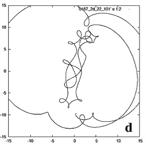
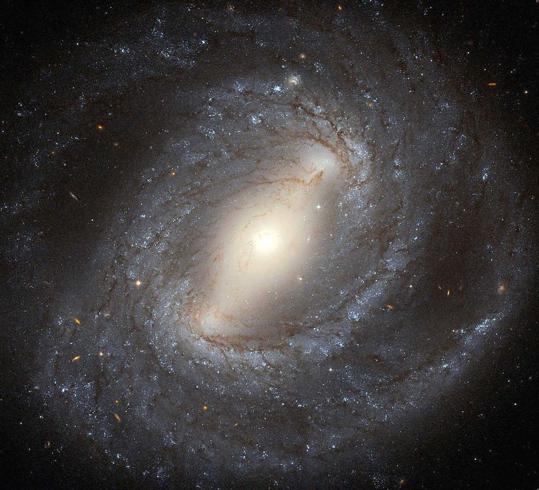
Fig 32: NGC 4394 is a remarkable galaxy in Coma Berenices which is too often overlooked in favour of nearby giant M85. The small spike-like dust feature in the upper bar plus the the two small “bulbs” in the bar-arm confluence indicates that N4394 is undergoing an ansae (“wings”) phase of early bar formation. When this phase occurs the bar’s wobbly box-shaped stellar orbits mix with stable periodic orbits of a the typical elongated x1 bar families. The small upper left inset shows how wobbly the orbits can be.
Of greater long-term importance are the “banana” resonance families (termed “manifolds” in Lea Athanassoula’s many papers). The gas tubes change shape and orientation over the lifetime of the galactic bar cycle. They demonstrate one of the primary purposes of bar cycles in galaxies, diffusing excess angular momentum as virial thermal cooling flow to the outer parts of the galaxy. The process can be thought of as a form of galactic lung system.
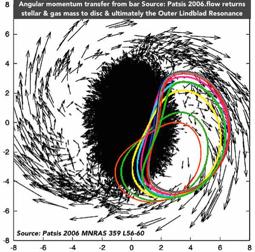
Fig. 33: NGC 3081 in Hydra, some 26.4 Kpc ( 86 million ly) from us, is a Type II Seyfert galaxy characterised by a dazzling high-energy nucleus powered by an actively accreting supermassive black hole. The dusty centre outlines an inner bar-spiral that evolved outwards from the core from a supernumerary Inner Lindblad Resonance (2ILR). The 2ILR itself evolved from the same core-bar circulatory friction which powered the original bar when the galaxy was a Grand Design spiral. Both ILRs arose from an instability in two sets of gas velocities amplified by resonance at the radius when the two velocities matched and thus reinforced one another. The ring-like periphery of the inner bar and the much larger more distant ring rimming the entire galaxy are both products of co-rotation physics in which the rotational period of the bar is the same as the rotation of the spiral wave and hence selfreinforcing. The inner spiral wave is easily discerned, but the outer spiral wave has been merged into a resonance ring. Large-diameter supernumerary resonance rings are abundant with bright blue young massive clusters <200 Myr old and bursts of new star formation <30 Myr old. So long as its gas reserves last, N3081 will spin up the excess gas in the inner accretion disc and eject it out the poles of the black hole into the halo above. The gas inside the polar jet will eject from the galaxy to high galactic altitudes from which it will return only very slowly over 100-million to half-billion-year time frames. The rest will flow outward via angular momentum to replenish the large outer resonance ring, which explains its present high star-formation rate. The “dead” zone between the two rings is a star-poor, gas-rich region so low-density that remote galaxies shine easily through. The rotational flows in various regions of the galaxy are evident in the streamlines of dust filaments. Note that the dust lanes in the “dead zone” are nearly circular, indicating little inward radial motion. The Hubble Wide Field Planetary Camera 2 (WFPC2) combined ultraviolet, optical, and infrared data to reveal distinctive warm and cold gas features of the galaxy in addition to its energetic star-forming zones. Source: Buta et al.,“A Hubble Space Telescope Study of Star Formation in the Inner Resonance Ring of NGC 3081”, A-J 2014 (49).

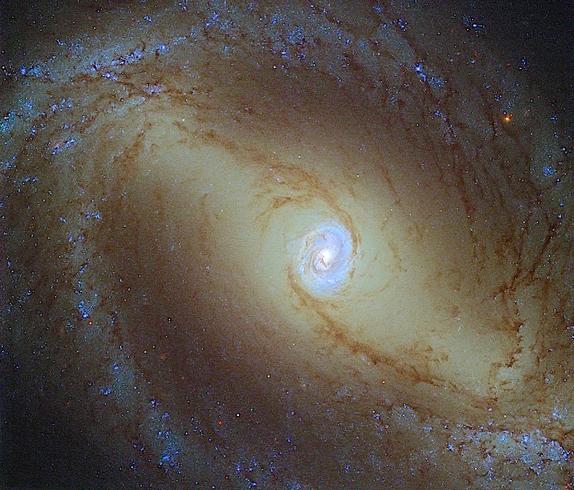
Fig. 34: Galactic bars are not as serene as their visual smoothness suggests. They are gas and dust, hence they extend and contract in length and thickness in relation to the density of the spiral arms which feed them and the dense bulge which consumes their gas and stellar inflow.
The bulge is the main heat engine of the galaxy. As with any heat source, its excess thermal (kinetic) energy has to go somewhere. Radiation rids the galaxy of the electromagnetic excess (which is not thermal). Much of the kinetic excess goes into making new stars. The rest is transported by the galactic wind of angular momentum transport back into the disc, where it ultimately fills and fuels the outer spiral arms. That is where the young clusters outside our solar circle in the Milky Way get much of their fuel.
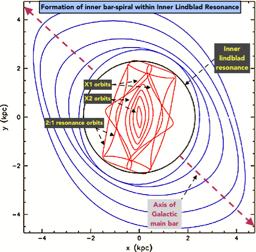
Note: This diagram is not to the same scale as the galaxy. In particular the drawing’s core region is greatly exaggerated in size while the oblate blue “kidney orbits” are too small.
As can be seen in the inset, the bulge of NGC 1433 has amassed enough gas to become unstable within the circle of its Inner Lindblad Resonance, initiating a succession of processes that will end hundreds of millions of years from now in a new spiral growing out of the bulge as the old spiral dissipates from mass loss feeding the old bar. The spiral-to-barto-bulge gas rejuvenation cycle will slowly progress until the galaxy indeed does run out of gas. That could be several Hubble times from now.
Presently the bulge is undergoing a perturbation in the harmony of its x1–x2 orbits and the 2:1 resonance orbits surrounding them. A new short-bar is forming, and from the tips of the short bar we can already see an infant spiral structure developing. The torque and shear forces that disrupt the spiral arm’s gas clouds are so strong that they decouple gas from its clouds and stream the gas into a featureless surface dotted occasionally with dust clouds twisted into filamentary shapes.
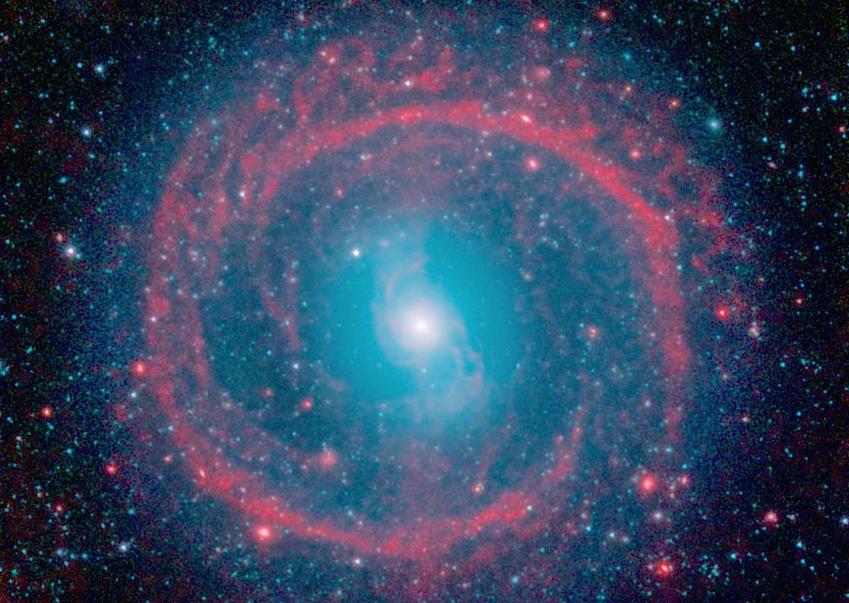
Fig. 35: The end of the rainbow for barred galaxy NGC 1291 Eridanus. The future fate of NGC 3081 in the previous image is all too clear here. This Spitzer Space Telescope view reveals the IR signatures of a galaxy that has undergone several cycles of bar formation and depletion. Successive cycles of bar formation fed by angular momentum transfer from the spiral arms into the bulge removed much of the galaxy’s original disc mass. The gas coming into the bulge fuelled an age of rapid star formation at the cost of depleting the gas reserves of the spiral arms inside the co-rotation circle (near the outer edge of the green barred region here). So much angular momentum was transported to the outer disc that it now holds most of the galaxy’s gas reserves. Perhaps 40% to 50% of this cold gas originated not from the galaxy itself but from “cosmic wind” infall along Cosmic Web filaments between massive galaxy superclusters like Virgo and Perseus-Pisces. The inner edge of the reddish circular ring marks the Outer Lindblad Resonance. Since the bulge can no longer access gas further out than the co-rotation circle, this galaxy has effectively starved itself of new star-forming gas — a phenomenon called “Bar Suicide”. Emptiedout spirals with star-forming rims are a small percentage of the barred spiral population, suggesting they lie in regions where there has been little interactivity with other massive galaxies.
Astronomers are uncertain whether this 10 million solar mass starburst region is part of NGC 925’s northern arm (the near side to us in this image) or is an infalling dwarf galaxy being tidally disrupted by the galaxy’s disc.
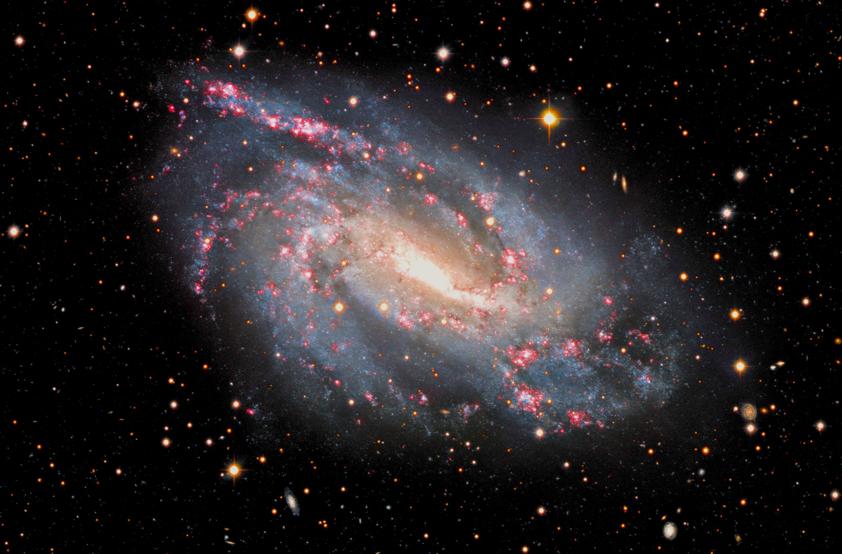
The late-type barred spiral NGC 925 in Triangulum has an unusual mass imbalance. The S and SE arms (bottom side on the far side of the galaxy in our line of sight) have benefited from more bar-generated mass transfer than the near-side NE and N arms. There are no galaxies near enough to have transferred mass into the galaxy, and no signs of collisionally disrupted arms. The bar is of recent genesis and is both tilted and decentred from the ancient bulge stars. The bar is undergoing star formation all along its length – an unusual property compared with the smooth sheen of many galactic bars. While its visual (blue) magnitude is 10.7 in the eyepiece, it is 7.9 in the K band infrared, which testifies to gas with a luminous kinetic heat capacity typical of highly active star-forming regions. If ever the tempestuous vigour of youth yearned for a role model, NGC 925 awaits you at +02h 27m 16s, +33° 34’ 45”.
The single image spread over the next four pages reveals the fulminous fury of a galaxy’s outer arms — in this case spanning the sky directly opposite the Milky Way’s core in Sagittarius. Here we see the outer Perseus Arm of the Milky Way from Taurus to the beak of Cytgnus, the star Albireo. One of a galaxy bar’s job descriptions is to redistribute excess gas flowing into the bulge outward to the remote reaches of the galaxy’s disc via the energy transfer mechanism of angular momentum. Once there the gas adds mass to the myriad atomic and molecular gas bubbles that drift into the disc from beyond the galactic reach. The ripped-to-shreds appearance of cold gas masses is vividly revealed via the AstroDon 5nm Halpha, 3nm O-III, and 3 nm S-II Hubble Palette filters employed to acquire the image. The original of this considerably scaled down image is a marvel of the abundance that simple physical laws of fluid mechanics and electromagnetic energy can conjure. See J-P Metsavainio’s 100,000 x 20,000 pixel original here.
A galactic bar is comparatively short,
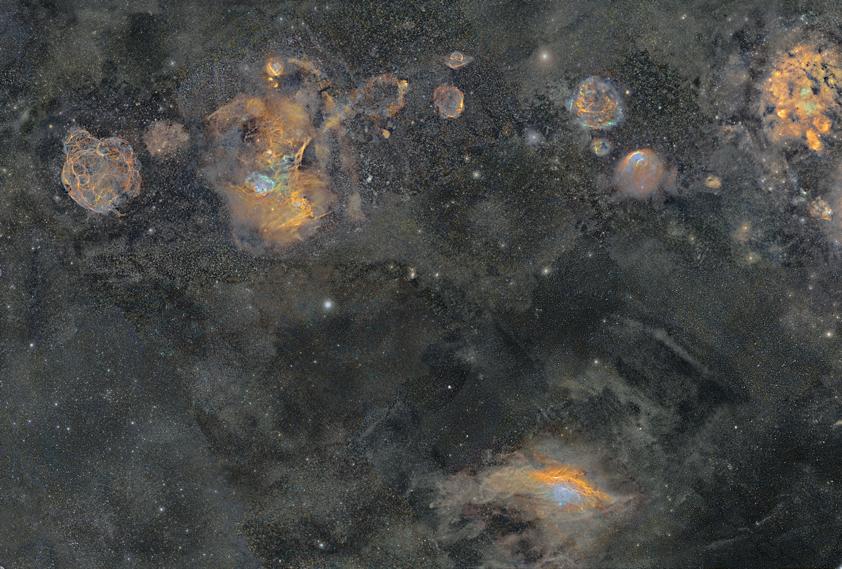 One third of the Milky Way central disc, from Simeis 147 in Taurus to the M27 Dumbbell planetary nebula in Vulpecula.
One third of the Milky Way central disc, from Simeis 147 in Taurus to the M27 Dumbbell planetary nebula in Vulpecula.
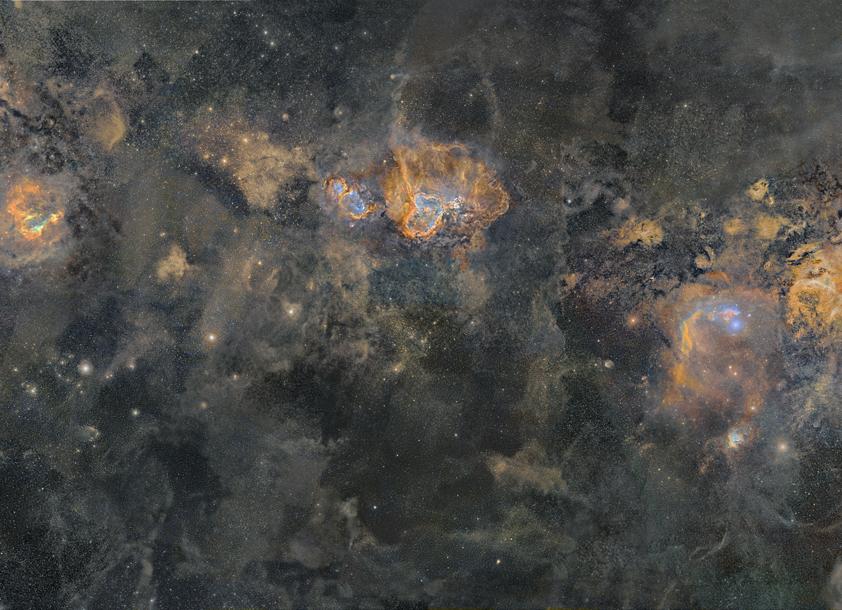

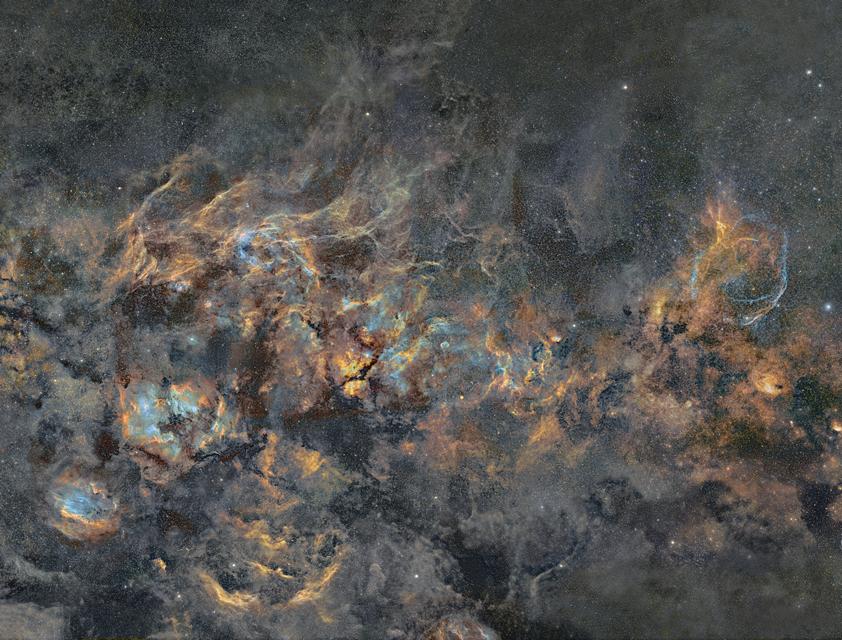
1. https://www.youtube.com/watch?v=H8HclL2znRk
2. https://www.youtube.com/watch?v=f4AEG2V-8Ok
3. https://www.youtube.com/watch?v=UKL9NIxLIIE
4. Sandage 1975. https://ned.ipac.caltech.edu/level5/Sandage/ paper.pdf
5. Tumlinson 2017. https://arxiv.org/abs/1709.09180
6. Duus & Freeman 1975. adsabs.harvard.edu/abs/1975dgs..conf..419D
7. https://www.wikiwand.com/en/Selection_bias
8. ircamera.as.arizona.edu/NatSci102/NatSci102/movies/galaxyrot.gif
9. Sofue 2008. https://arxiv.org/abs/0811.0859
10. https://www.wikiwand.com/en/Bertil_Lindblad
11. https://www.wikiwand.com/en/Lindblad_resonance
12. https://www.google.co.za/search?
q=Bertil+Lindblad+and+galactic+resonances&dcr=0&tbm=isch&tbo =u&source=univ&sa=X&ved=2ahUKEwi_8IOQ04rdAhUNeMAKHYDd AtEQsAR6BAgCEAE&biw=1434&bih=931
13. casa.colorado.edu/~danforth/science/spiral/
14. Putman et al. 2002. adsabs.harvard.edu/abs/2002AJ....123..873P
15. Putman & Moore 2002. adsabs.harvard.edu/abs/ 2002ASPC..276..127P
16. De Heij et al 2002. adsabs.harvard.edu/abs/2002A&A...392..417D
17. Gibson et al. 2000. https://ui.adsabs.harvard.edu/abs/ 2000Obs...120...76G/abstract
18. https://www2011.mpe.mpg.de/opinas/research/DynamicsGroup/ research/bulges+bars/wegg_bulge.mp4
19. Kormendy 2014. https://ned.ipac.caltech.edu/level5/March10/
20. Borosen, 1981. adsabs.harvard.edu/cgi-bin/bib_query? 1981ApJS...46..177B
21. Athanassoula 2005. adsabs.harvard.edu/cgi-bin/bib_query? 1981ApJS...46..177B
22. https://www2011.mpe.mpg.de/opinas/research/ DynamicsGroup/research/bulges+bars/bulges+bars.html
23. Bournaud & Combes 2002. https://arxiv.org/abs/astro-ph/ 0206273
24. Kormendy 2004. https://arxiv.org/abs/astro-ph/0206273
25. Tirapagui & Zeller 1993. https://books.google.co.za/books? id=HY_pCAAAQBAJ&pg=PA305&lpg=PA305&dq=Rayleigh+d iscriminant&source=bl&ots=aeX4OD1GT&sig=oDDpjgUGhM3LDY6dKN2SStSiv5o&hl=en&sa=X&ve d=2ahUKEwj00_W_g8rdAhVDeMAKHZqC0IQ6AEwCnoECAQQAQ#v=onepage&q=Rayleigh%20discri minant&f=false
26. Athanassoula 2012. https://academic.oup.com/mnrasl/article/ 426/1/L46/988519
27. https://www.wikiwand.com/en/Viscous_stress_tensor
28. https://www.star.ac.za/astrophysical-fluid-dynamics
29. www.astro.yale.edu/vdbosch/astro320_summary6.pdf
30. Libeskind et al 2015. https://arxiv.org/abs/1503.05915
31. Jim Stone https://www.astro.princeton.edu/~jstone/images/ galmovie.mpg
32. Kormendy 2013. https://arxiv.org/abs/1311.2609
33. Leprovost & Kim 2008. https://journals.aps.org/prl/abstract/10.1103/ PhysRevLett.100.144502.
34. Reid et al 2009. https://iopscience.iop.org/article/10.1088/0004-637X/ 700/1/137/meta
35. Dobbs & Pringle, 2010. https://ui.adsabs.harvard.edu/abs/ 2010MNRAS.409..396D/abstract
36. Dobbs, Pringle et al 2014. https://ui.adsabs.harvard.edu/abs/ 2014MNRAS.437L..31D/abstract
37. Elmegreen 2007. https://iopscience.iop.org/article/10.1086/521327/meta
38. Chandar et al 2007. iopscience.iop.org/article/10.1088/0004-637X/727/2/88/ meta
39. Gavazzi et al 2013. https://arxiv.org/abs/1505.07836
40. Bullis 2018, The Winds of Change Are Blowing Over Aquila https://issuu.com/ douglasbullis/docs/nightfall_special_report__5-winds_o
41. Athanassoula 2002. https://arxiv.org/abs/astro-ph/0209438
42. Wibking & Krumholz 2021. https://arxiv.org/abs/2105.04136
43. Stein et al 2020. https://arxiv.org/abs/2007.03002v1
44. Athanassoula 2005. https://academic.oup.com/mnras/article/ 358/4/1477/1071570
45. Porteil et al 2015. https://arxiv.org/abs/1503.07203
46. Jenkins et al 2011. https://iopscience.iop.org/article/10.1088/0004-637X/ 734/1/33/meta
47. Díaz-Garcia et al 2015. https://www.aanda.org/articles/aa/abs/2016/03/ aa26161-15/aa26161-15.html
48. Patsis 2006. https://www.aanda.org/articles/aa/abs/2016/03/aa26161-15/ aa26161-15.html
49. Buta et al 2004. https://iopscience.iop.org/article/10.1086/382239

